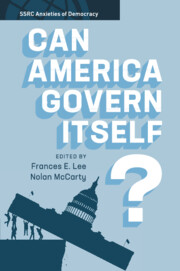Book contents
- Can America Govern Itself?
- SSRC Anxieties of Democracy
- Sponsored by the Social Science Research Council
- Can America Govern Itself?
- Copyright page
- Contents
- Acknowledgments
- 1 The Anxieties of American Democracy
- Part I Anxieties of Power, Influence, and Representation
- Part II Procedural Anxieties
- 7 Does Regular Order Produce a More Deliberative Congress?
- 8 Congress at Work
- 9 Dumbing Down?
- Part III Anxieties of Governance
- Index
- Index Authors
- References
8 - Congress at Work
Legislative Capacity and Entrepreneurship in the Contemporary Congress
from Part II - Procedural Anxieties
Published online by Cambridge University Press: 25 May 2019
- Can America Govern Itself?
- SSRC Anxieties of Democracy
- Sponsored by the Social Science Research Council
- Can America Govern Itself?
- Copyright page
- Contents
- Acknowledgments
- 1 The Anxieties of American Democracy
- Part I Anxieties of Power, Influence, and Representation
- Part II Procedural Anxieties
- 7 Does Regular Order Produce a More Deliberative Congress?
- 8 Congress at Work
- 9 Dumbing Down?
- Part III Anxieties of Governance
- Index
- Index Authors
- References
Summary
Scholars and observers worry that Congress has lost its capacity to perform its functions in the American political system. Drawing on an array of data on Congress’s activities and processes along with in-depth interviews with long-serving lawmakers and high-level staffers, we take stock of how changes to internal processes have affected Congress’s institutional capacities. In doing so, we make two interrelated arguments. First, we argue that Congress can take transformative action whether the legislative process is centralized and leadership-led or whether it is decentralized and committee-led. Second, we argue that Congress is better able than in previous eras to engage in conflict-clarifying representation in order to express and educate the public on the positions of the parties. We conclude that changes to congressional processes in recent years should be viewed as adaptations to the challenges of contemporary lawmaking. These adaptations help preserve Congress’s institutional capacity, but they have undoubtedly had negative consequences for open deliberation and individual member input into legislation.
- Type
- Chapter
- Information
- Can America Govern Itself? , pp. 181 - 219Publisher: Cambridge University PressPrint publication year: 2019



